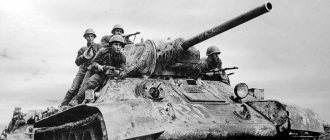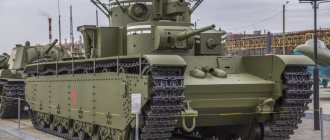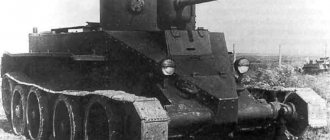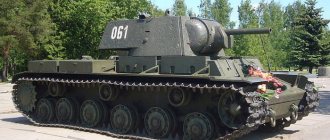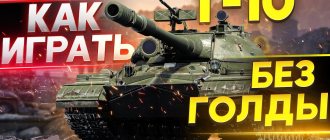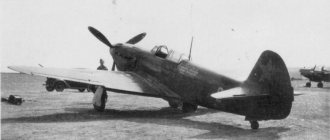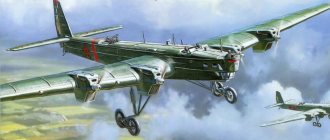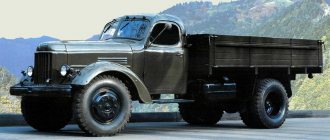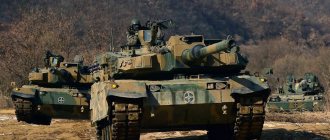Photo: Anton Tushin
On October 11, Uralvagonzavod, a unique research and production complex in Russia, one of the largest industrial enterprises in the world, celebrated its 84th birthday.
It was on this day in 1936 that the first heavy-duty gondola cars rolled off the plant’s assembly line, and UVZ entered into operation at existing enterprises. Uralvagonzavod became known not only for its rolling stock.
Within the walls of the plant, legends of world tank building were created - the T-54/55, the most popular modern tank T-72, the advanced T-90 and its modifications, as well as armored vehicles on the Armata platform. In total, the plant produced more than 100 thousand units of armored vehicles - and this is an unconditional world record in tank building. Birth of an industrial giant
The history of the creation of UVZ, like the history of other giant construction projects of the first five-year plans of the Soviet Union, is woven from both heroic and tragic events. The growth of the young country's industry and its vast territories required a large amount of railway equipment, which was sorely lacking. In the spring of 1931, a decision was made to create a carriage plant, with the help of which it was planned to increase the country's carriage fleet by one and a half times by 1937.
The future Uralvagonzavod was designed in accordance with American know-how on the principles of flow-conveyor production. At the same time, it became one of the first industrial enterprises of the USSR, designed without the participation of foreign specialists.
Photo: Nizhny Tagil City Historical Archive
Large-scale construction began in the Nizhny Tagil region, which belonged to the Ural-Kuzbass coal and metallurgical complex. In the first years, builders faced a lot of problems; due to hard work and instability, workers left the construction site in the thousands.
Despite all the difficulties, on October 11, 1936, the plant produced the first heavy-duty gondola car, and this date is considered the birthday of the enterprise. Gradually, Uralvagonzavod reached its planned capacity and during the pre-war period produced 35,400 cars of various types - twice as many as all the country's car-building enterprises during the years of the first and second five-year plans.
The history of the T-34
The first tanks in Russia began to be developed in pre-revolutionary times. The ancestor of the first Russian car was the French captured tank Renault FT-17. Tank building dates back to 1914 with the creation of an armored vehicle on a wheeled-tracked "All-terrain vehicle". Later, other prototypes appeared, but the shortcomings of their design did not yet allow them to carry out combat missions.
photo: format72.ru French tank Renault FT-17
In 1919, the USSR again took up the creation of combat vehicles, but now the developments of Western, in particular French and English designers, were taken as a basis.
Tank T-24 and BT
In the 20s and 30s, tank building, as an advanced industry, was overflowing with ideas and new design solutions. This is the period of creation of the T-24 with 45 mm. gun, a series of light BT tanks with good maneuverability and speed. However, they all had a number of significant drawbacks. These include a gasoline engine, which entails a high risk of fire when hit by a projectile, as well as high production costs.
Medium Soviet tank T-24
The Spanish Civil War (1936-1939) became for the young USSR a kind of testing ground for new types of weapons, including tanks.
In May 1938, Joseph Vissarionovich Stalin invited engineers and tank crews who had visited the battlefields in Spain. They were faced with the question of what kind of modernization the tanks needed. During the discussions, it was decided to create a fully tracked vehicle. Before this, the vehicles used tracked wheels.
Designer M.I. Koshkin, creator of the T-34 tank
However, without the direct control of the Supreme Commander-in-Chief, back in October 1937, on the territory of the Kharkov Locomotive Plant, the head of the design bureau, Mikhail Ilyich Koshkin, together with A. A. Morozov and N. A. Kucherenko, began creating a new tank, without relying on Western analogues designers. The combat vehicle was based on a diesel engine. Thick armor plates, 4-7 cm thick, were positioned at a steep angle of 60⁰ so that enemy shells, in the event of a frontal attack, would ricochet off the hull. The 76 mm cannon had a firing range of up to 1 km.
Mikhail Ilyich Koshkin, chief designer of the T-34 tank
In March 1940, 2 prototypes of the new tank made a run from Kharkov to Moscow. The road led around the cities along country roads. The goal was not only to bring samples of tanks to the authorities, but also to test combat vehicles. The task was of paramount importance; the head of the design bureau, M.I. Koshkin, volunteered to lead one of the tanks himself.
The vehicles were delivered to Moscow on time, the tanks were given a comprehensive study, and mass production of the new T-34 combat vehicle began at the beginning of 1941. Unfortunately, driving the tank along the route Kharkov - Moscow had a negative impact on the health of its inventor, and in September 1940, M. I. Koshkin died of pneumonia.
An important reason for the transition to new tanks was the results of the war with Finland (1939-1940). It was she who showed the shortcomings of existing machines. Light tanks BT-5 and BT-7, as well as T-26 tanks with a gasoline engine, successfully won both tank battles that took place during this war. However, hundreds of tanks simply froze without entering the battle.
Light tank BT-5
The attack of Nazi Germany on June 22, 1941 took the tank units by surprise. Many cars were burned right on the platforms. Those that remained could not give a worthy rebuff: there were not enough shells, there was no one to lead the new vehicles into battle, and the tankers were not trained to operate the new vehicles. Thus, out of about a thousand tanks defending the western borders of the country, almost all were lost in the first two weeks of fighting. And in the fall of 1941, the Kharkov Locomotive Plant, which produced the bulk of the T-34, was destroyed.
Post-war years
After the war, the plant returned to its previous name and its previous type of activity - the production of railway cars. The experience of the war years allowed UVZ to quickly recover and rise to a new level. The plant is expanding its activities. In addition to various types of cars, the production of military equipment continues here, and orders for agricultural, construction and aerospace equipment are also fulfilled.
At the end of the 1940s, the Nizhny Tagil plant began production of the T-54 tank, which played an important deterrent role during the Cold War. Since January 1958, UVZ has been producing the T-55, the world's first tank capable of operating in a nuclear war. This model became the most popular tank of the 1960-1970s.
Tank T-72. Photo: Russian Ministry of Defense
The next successor to the T-34 traditions was the T-62 tank, created in the early 1960s, the world’s first tank with a smoothbore gun. And in 1973, UVZ began and continues to produce an improved design of the T-72 tank - the most popular tank of our time, which still forms the basis of the tank forces of many countries. It is noteworthy that the tank was not only produced, but also developed in Nizhny Tagil. On the basis of the T-72 tank, UVZ produced engineering vehicles.
Another interesting area of UVZ’s work at this time was the creation of cryogenic equipment. In 1954, the plant received its first task to develop experimental units for filling rockets with liquid oxygen. In 1956, production of refueling equipment began, and since then all Soviet and Russian space projects have been associated with the activities of Uralkriomash, a division of UVZ. Today the plant is the only manufacturer in Russia and the CIS countries of specialized cryogenic railway tanks for the transportation of liquid nitrogen, argon, oxygen and hydrogen.
T-34 in the Great Patriotic War
Having recovered from the first shock, the army of the Soviet Union begins retaliatory military operations. Formed tank divisions enter the battle. And here the advantages of the new T-34 become a big problem for the enemy. T-34 cannons penetrate the armor of any German tank at a kilometer distance - not a single one of the vehicles in the fascist arsenal can resist this. In view of this, it was decided to postpone the attack on the city of Tula planned by the Germans for the fall.
The losses of USSR combat vehicles since the beginning of the war have been enormous. Thus, in 1941, the Soviet Union lost about 20.5 thousand tanks of all types. To make up for the lack of combat vehicles, factories moved to the Urals and Siberia are urgently producing new tanks, the bulk of which are T-34s. During the production process, another advantage of the 34th appeared - the simplicity of the design of the new equipment. Many production operations could be performed by low-skilled workers without special knowledge. This was very important, because the main workforce after workers left for the front were women and children.
KV-2 legendary Soviet heavy assault tank
The winter of 1941-1942 was marked by fierce battles for Moscow. The Germans brought about 650 tanks against Rokossovsky's army. However, the defenders turned the tide of the battle - they not only prevented the enemy from approaching the capital, but also launched a counter-offensive. In January 1942, the unfolding Red Army offensive could have changed the course of the war: it was planned to capture the main Army Group Center, which would have allowed the war to end much earlier. But there were still not enough tanks for such a strike, and the chance was missed.
The year 1942 was marked by the restoration of the power of tank forces. Factories are increasing production, and for the first time, in-line production of the T-34 has been established. A major achievement was the development of an automatic electric welding method, thanks to which the production of tanks increases 5 times without compromising quality. Field tests have shown that the seams welded with new electric welding equipment are stronger than even tank armor.
In 1942, there were already 20 tank corps. Now tanks play an important role in military confrontation. If in the early 40s they were assigned the role of only accompanying infantry, now they are an independent force. The battles showed that Soviet tanks were superior to enemy combat vehicles. As evidence, in battles on the outskirts of Stalingrad 200 km away. to the city, T-34s defeated the tank corps of the commander of the Don army, Manstein.
Nazi tank "Royal Tiger": superweapon or supermyth? |
German designers, having studied the advantages of the T-34, are producing new types of tanks. The Tiger and Panther combat vehicles received new armor and a firing range of about 1.5-2 km. The Ferdinand self-propelled artillery mount had an 88 mm cannon and 20 cm armor. It was with these machines that the Germans planned to win the Battle of Kursk and launch a counteroffensive after the failure at Stalingrad.
HISTORY OF CREATION
HISTORY OF CREATION
Heavy tank "Tiger" in the exhibition of captured military equipment at the Gorky Central Park of Culture and Culture. Moscow, March 1944. Mortars for launching S-type anti-personnel mines are clearly visible.
“Tiger”, “Tiger”, “Tigris” - this word, pronounced in Russian, English, Polish, French by soldiers of the armies of the anti-Hitler coalition, made hearts beat faster, if not from fear, then from a sense of mortal danger. At these moments, in the minds of the soldiers it was not the image of a ferocious tabby cat that arose, but the image of an invulnerable steel hulk, spewing fire and death.
Created by the "gloomy German genius", this, without any doubt, the most formidable German tank of the Second World War was a perfect example of military equipment. And if the other two most famous tanks of those years - the T-34 and the Sherman - owe much of their fame to gigantic production volumes, then the Tiger owes their fame to exceptionally outstanding combat qualities. And one can only bitterly regret that these qualities were used in the struggle for a wrong cause...
Real work on creating a new heavy tank as part of the Panzerkampfwagen VI program began at the end of January 1937, when Henschel received an order to design a combat vehicle under the symbol DW1 (Durchbruchwagen - breakthrough vehicle). The hull of this 30-ton tank consisted of two parts, connected to each other by bolts - metallurgical plants were not yet able at that time to produce large-sized rolled armor plates with a thickness of 50 mm. The undercarriage consisted of five rubber-coated road wheels and three support rollers on board, a front drive wheel with ridge gearing and a 300 mm wide track. Suspension - individual, torsion bar. The tested tank chassis with ballast instead of a turret was equipped with a 280-horsepower Maybach HL 120 engine, a Maybach Variorex gearbox and a Cletrac-type turning mechanism. Maximum speed 35 km/h.
Developed since September 1938, the DW2 version had differences from its predecessor in the design of the gearbox, parking brake, tracks, final drives, drive wheels and suspension. It was planned to install a Pz.Kpfw.IV turret with a 75-mm cannon and a coaxial MG 34 machine gun on the tank. The second machine gun was supposed to be installed in the front plate of the hull on the right. As in the first case, the matter was limited to the construction and testing of the chassis.
The experimental tank VK 3001(H), which followed the first two prototypes and was created, like them, under the leadership of the head of the advanced development department of Henschel Erwin Aders, the thickness of the frontal armor of the hull was increased to 60 mm, a 520 mm wide track was used and road wheels were placed in a checkerboard pattern. 6-cylinder Maybach HL 116 engine with 300 hp. at 3000 rpm allowed a 30-ton combat vehicle to move at a speed of 35 km/h. Three prototype chassis were manufactured and used to test various components and assemblies. When Hitler ordered the development of self-propelled anti-tank guns with powerful 105 and 128 mm caliber guns in May 1941, another use was found for the VK 3001(H) built. On the basis of two chassis of this type, the Rheinmetall-Borsig company in Düsseldorf manufactured heavy self-propelled guns 12.8 cm Panzer-Selbstfahrlafette V. 128-mm Ger?t 40 cannon with a barrel length of 61 calibers and an initial projectile speed of 910 m/s, created on the basis of an anti-aircraft gun guns, was installed in an open-top wheelhouse in the aft part of the hull. To accommodate a gun weighing 7 tons, it was necessary to lengthen the chassis by introducing an eighth track roller. The cabin with a wall thickness of 30 mm accommodated 5 crew members and 18 cannon shots. The weight of the vehicle reached 36 tons. Both self-propelled guns were sent to the Eastern Front, where one of them was captured by Soviet troops in the fall of 1943. Currently, this unique vehicle is an exhibit of the tank museum in Kubinka.
In parallel with the Henschel company, Porsche also worked on the project of a new heavy tank. The VK 3001(P) vehicle, the first to be created in the workshops of the new Nibelungenwerke plant, received (Leopard) the designation Tour 100. Two prototype chassis were built, remaining without towers, which were never received from Krupp. The main feature of the Porsche chassis was the electromechanical transmission. Two engines manufactured by the Viennese company Simmering-Graz-Pauker AG, each producing 210 hp. each rotated two generators, which, in turn, drove two electric motors. From them the torque was transmitted to the drive wheels. The tank was supposed to receive a modified turret from the Pz.IV with a 75-mm short-barreled gun. In the future, it was planned to install a 105-mm L/28 cannon on the Leopard. In 1941–1942, both vehicles underwent testing, which was often interrupted due to numerous problems with the transmission.
In May 1941, during a meeting at the Berghof, Hitler proposed a new concept for a heavy tank, which had increased firepower and armor protection and was designed to become the striking force of tank formations, each of which was supposed to have 20 such vehicles. In the light of the Fuhrer's proposals and taking into account the test results of experimental heavy tanks, tactical and technical requirements were developed, and then an order was issued to Porsche for the development of the VK 4501(P) tank with an 88-mm cannon and to Henschel for the VK 3601(H) with a cannon with a conical barrel. It was planned to produce prototypes by May - June 1942.
Work on assembling the Sonderfahrzeug II, or Tour 101, officially named in the weapons department documents as Panzerkampfwagen VI, VK 4501 (P) Tiger (P), was carried out in the workshops of the Nibelungenwerke plant. The layout of both the tank itself and the engine and transmission compartment remained the same as that of the VK 3001(P). Two 10-cylinder V-shaped air-cooled carburetor engines Tour 101/1 located parallel to each other with a power of 320 hp. each, using a V-belt drive, rotated the rotors of two generators. From the latter, electricity was supplied to two electric motors that rotated the drive wheels of the tank. The entire electrical part of the transmission was supplied by Siemens-Schuckert. As for the tower, it was developed proactively by Krupp in close cooperation with Porsche.
Meanwhile, the Henschel company is quickly designing, manufacturing and testing its VK 3601(H), which according to documents was also known as the Panzerkampfwagen VI Ausf.B. There were no problems with the chassis: the engine-transmission group and chassis were well developed on previous models. A combat vehicle weighing 36 tons, protected by 100 mm frontal armor, reached a speed of 40 km/h. As for the turret and weapons, they were never created for this tank. The fact is that the Krupp company offered its Ger?t 725 - a 75-mm cannon with a conical barrel. But when it turned out that the armor-piercing projectile of this gun included a tungsten core weighing 1 kg, it was hastily abandoned - the ammunition of this gun would have “eaten up” the entire tungsten limit of the Wehrmacht. Having successfully passed the tests, which, by the way, were attended by the Minister of Armaments A. Speer, the vehicle was out of work. However, not for long...
Note that the VK 3601(H) was considered from the very beginning as an intermediate model, as a step to the next, more powerful combat vehicle. No wonder the planned production of this tank was limited to 172 copies. Since the initial version of the weapon turned out to be unsuccessful, and deadlines were running out, it was necessary to look for some new solution. And they found it - a Krupp turret designed for the VK 4501(P) was installed on the tank. True, this required increasing the clear diameter of the turret ring from 1650 to 1850 mm, which caused a change in the upper part of the hull. The VK 3601(H) received fender niches, and the weight increased to 45 tons. Design changes also led to a change in the index: the tank began to be called VK 4501(H). The main thing was that E. Aders’ car, as well as F. Porsche’s tank, was equipped with an 88-mm tank gun.
Self-propelled artillery mount 12.8 cm Panzer-Selbstfahrlafette V.
This gun was developed by Friedrich Krupp AG using the oscillating part of the 8.8 cm Flak 18/36 anti-aircraft gun - the famous "acht-acht" ("eight-eight"), without a doubt the most famous artillery piece of the Second World War. In the tank version, having received a muzzle brake and electric trigger, the gun became known as the 8.8-cm KwK 36.
However, a second armament option was also envisaged for the Henschel tank - a 75-mm KwK 42 L/70 cannon in a Rheinmetall-Borsig turret. A special feature of this turret, which was made only as a life-size wooden model, was the stern MG 34 machine gun in a ball mount. The vehicle with the Rheinmetall turret had the index H2, and the one with the Krupp one - H1.
In March 1942, Hitler proposed sending prototypes of heavy tanks to the front in order to test them in real combat conditions. Soon after this very dubious proposal, he announced how many tanks should be ready by October 1942 and March 1943. It was a complete departure from reality to demand the arrival of 60 vehicles from Porsche and 25 from Henschel by the end of September 1942, and another 135 combat vehicles from both companies by the end of February 1943. It should be noted here that both tanks were actually already put into production before any serious testing began. In the Nibelungenwerke factory workshops, the assembly of a pilot batch of 10 VK 4501(P) machines began, and 90 towers were ordered from Krupp. Following this, F. Porsche planned to produce 35 tanks by January 1943 and 45 by April. His competitor went even further: production of the first 60 VK 4501(H) machines began already in mid-1941, and although only one copy was ready by the spring of 1942, the components and assemblies of the rest were not lost - they were later used in the assembly of serial “tigers” "
On April 20, 1942, Hitler's birthday, both tanks were shown to the Fuhrer at his Wolfsschanze headquarters in East Prussia. Moreover, during the delivery of the VK 4501(H), certain difficulties arose, since the tank’s tracks protruded 50 mm beyond the dimensions of the railway platform on each side. While the tank was being transported, traffic on all sections of the Kassel-Rastenburg railway line had to be blocked. F. Porsche's tank was not without problems - when unloading from the platform under its own power, the heavy vehicle got stuck in the ground. The Khenshelevites prudently used a 70-ton railway crane for this purpose, and the Porshevo team decided to show off. In the end, they still had to resort to using a crane.
The next day both cars arrived at the headquarters. At 10.30, as follows from the memoirs of Erwin Aders, the leaders of the Reich and the Wehrmacht began to gather. Goebbels and Goering were absent. When Hitler appeared at 11:00, employees of the manufacturing companies lined up to present themselves to the Fuhrer. Then Ferdinand Porsche was awarded the Military Merit Cross, 1st class. After the ceremonial part, Hitler examined the Porsche car for about half an hour, carefully listening to the designers’ explanations. He spent only 2-3 minutes with Henschel’s tank, asked Aders one question and walked away. Then there was a display of tanks in motion.
After lunch Goering arrived. In the presence of him and Armaments Minister Speer, speed tests took place. On a section of 1000 m, VK 4501(P) reached a maximum speed of 50 km/h, and its competitor on a section of 850 m reached 45 km/h. In this case, the VK 4501(H) engine overheated so much that there was a risk of fire. After the engine cooled down, the tank was ready for action again. Henschel chief engineer Kurt Arnold offered Speer comparative maneuverability tests, apparently not without a secret intent: he knew well the weak points of the Porsche car. The crude, unfinished electric transmission seriously hampered the maneuvering of the VK 4501(P), for example, the tank made 90° turns with great difficulty. Against this background, VK 4501(N) showed its best side - the multi-ton machine was literally spinning on its heels, delighting the audience.
Pz.Kpfw.VI Tiger Ausf.H1 (early production vehicle).
However, this demonstration of tanks, in fact, did not solve anything - real tests lay ahead at the Berka training ground, where two VK 4501(P) and one VK 4501(H) arrived in May 1942. As a result, the Porsche tank, as in the case of the VK 3001(P), was found to have low reliability of the electric transmission. In addition, the car had unsatisfactory cross-country ability and a small power reserve - only 50 km. Since Hitler wanted to use new tanks in North Africa, this figure had to be at least 150 km. It turned out to be impossible to place additional fuel in the tank due to lack of space. It was easy to foresee the numerous difficulties that could arise when operating a combat vehicle at the front. The unusual transmission required retraining of driver mechanics and repair service specialists.
One of the first serial "tigers" at the factory yard. The placement of headlights on the front of the body is typical for early models.
After weighing all the pros and cons, despite Hitler’s special affection for Dr. Porsche, the commission conducting the tests decided in favor of the Henschel tank. Hitler was forced to agree. The vehicle received the designation Pz.Kpfw.VI (Sd.Kfz.181) Tiger Ausf.H1, and after the Tiger II tank was put into service in 1944, the name was changed to Tiger Ausf.E or Tiger I. VK chassis already manufactured at the Nibelungenwerke 90 plant 4501(P) it was decided to use as a base for heavy assault guns armed with an 88-mm anti-tank gun, created on the basis of the Flak 41 anti-aircraft gun with a barrel length of 71 calibers - the future Ferdinands.
Early release tower.
At the beginning of August 1942, mass production of a new heavy tank began, which, however, did not mean the end of testing. They continued, but already at the main Wehrmacht tank training ground in Kummersdorf. The first tank had covered 960 km by that time. On moderately rough terrain, the car reached speeds of up to 18 km/h, while fuel consumption was 430 liters per 100 km.
Mortars for firing smoke grenades:
1 - front view; 2 - rear view.
Installation of the tower in the factory workshop.
By August 18, 1942, the first 4 “tigers” were released. The fifth and sixth vehicles were sent to Fallingbostel on August 27, where the 501st and 502nd heavy tank battalions were formed. The tanks were assembled at the Henschel plant in Kassel. The Wegmann company was involved in the production of the towers. During mass production, changes and improvements were almost continuously made to the design of the tank, which was produced in one modification. The very first production vehicles had a modified box for equipment and spare parts, which was mounted on the rear of the turret. The prototypes used a box borrowed from the PzIII. The hatch with a loophole for firing personal weapons on the right wall of the tower was replaced with a manhole hatch. For self-defense from enemy infantry, mortars for anti-personnel mines of the “S” type were mounted along the perimeter of the hull. This mine, the warhead of which included 360 steel balls, was fired at a small height and exploded. In addition, NbK 39 smoke grenade launchers of 90 mm caliber (three on each side) were installed on the turrets of early production tanks. The latter could also be used to fire S-type mines. On later production vehicles, this purpose was served by a “close defense weapon” - Nahverteidigungswaffe - a mortar installed inside the tank and fired through an embrasure located on the roof of the turret behind the loader’s hatch.
From the second half of 1943, the Tigers began to be equipped with a new commander's cupola (from the 391st vehicle), unified with the Panther cupola and having a device for mounting an MG 34 anti-aircraft machine gun, as well as a periscope observation device in front of the loader's hatch. Changes were made to the gun's trigger mechanism, to the gun's travel stopper, to the mounting of the coaxial machine gun, to the seats of the crew members, etc. On its sides, a stowage of spare tracks was placed, which had previously been located only on the lower frontal plate of the hull. Five tracks were attached on the left side, and three on the right side.
Roof of the engine compartment with installed equipment for underwater driving:
1 — exhaust pipes; 2 — OPVT pipe; 3 — Feifel type air filters; 4 — cap over the air exhaust window; 5 — air supply pipes to engine air filters; 6 - air supply pipes to Feifel type filters.
The tank's power plant has also undergone changes. The first 250 cars were equipped with a Maybach HL 210P30 engine, the rest - a Maybach HL 230P45. For operation in the African desert and in the southern regions of Russia, Feifel type air filters were mounted on the stern plate of the hull.
The first 495 tanks were equipped with equipment for underwater driving, which made it possible to overcome water obstacles up to 4 m deep at their own pace along the bottom. A three-meter telescopic pipe was installed above a special hatch in the roof of the engine compartment to supply air to the engine. The exhaust was made directly into the water. All tank hatches had rubber seals. The engine partition was sealed with special care so that exhaust gases did not penetrate into the habitable compartments of the tank. During tests at the factory site, where a special pool was built for this purpose, the tank with the engine running was under water for up to 2.5 hours. At that time, the Tiger was the only production tank in the world equipped en masse with underwater driving equipment, which found widespread use in tank building only in the 50s. True, this equipment was practically not used by the troops and was abandoned over time.
The weak point of the Tiger's chassis, which could not be eliminated, was the rapid wear and subsequent destruction of the rubber tires of the road wheels. Starting with the 800th vehicle, road wheels with internal shock absorption and steel tires began to be installed on the tank. At the same time, the outer row of single rollers was removed.
The Tigers used two types of tracks: transport, 520 mm wide, and combat, 725 mm wide. The first ones were used for transportation by rail in order to fit into the dimensions of the platform, and for moving under their own power on paved roads outside of combat. (When transporting tanks, the external road wheels were often removed.) When using transport tracks, the specific pressure on the ground increased to 1.53 kg/cm2.
In 1943, 84 tanks were converted into a command version. The ammunition load was reduced to 66 rounds, the coaxial machine gun was removed and additional radio equipment was installed. Depending on the purpose, command tanks Pz.Bef.Wg. Tiger Ausf.E existed in two versions, differing in the set of radio stations. The Sd.Kfz.267 with Fu 5 and Fu 8 radio stations was intended for the divisional level, and the Sd.Kfz.268 with Fu 5 and Fu 7 was intended for company and battalion commanders.
Several “tigers” were converted into ARVs, and, apparently, by the military units’ own forces—there was no “proprietary” version of such a vehicle. One vehicle with the cannon removed and crane equipment installed on the turret was captured by the Allies in Italy. In some cases, tank chassis without a turret were used as tractors. Basically, Vergepanther ARVs and FAMO (Sd.Kfz.9) half-track tractors were used to evacuate damaged heavy tanks from the battlefield.
"Tiger" of the 501st heavy tank battalion in Tunisia, 1943. Feifel-type inertial air filters are clearly visible on the rear hull plate.
In the fall of 1943, at Hitler's insistence, an 88-mm KwK 43 cannon with a barrel length of 71 calibers was experimentally installed in the standard H1 turret. But at this time, the development of the VK 4503 tank, the future “Royal Tiger”, was already underway, the dimensions of the turret of which were much more suitable for the new gun.
Production of the Tiger heavy tank
The only country to which the Tiger was exported was Hungary, Germany’s most staunch and bravely fought ally. The tanks were delivered there in July 1944. Their number (according to different sources) ranges from 3 to 13 units. These were vehicles of different vintages, apparently transferred from one of the heavy tank battalions from the Eastern Front. On December 7, 1944, four Tigers were part of the 2nd Hungarian Tank Division. Judging by the photographs, these vehicles were also part of the 1st Cavalry Division, which fought against Soviet troops in eastern Poland.
In the summer of 1943, three tanks were transferred to the Italians for temporary use. After the capitulation of Italy, they were returned again to the Panzerwaffe banner.
The Tiger is the first captured by American troops in North Africa. On the right wall of the tower there is a hatch with a loophole for firing from personal weapons, later replaced by a manhole.
A curious story happened with the Japanese, who showed increased interest in the new German tanks. On June 7, 1943, the Japanese ambassador to Germany, General Oshima, observed the combat operations of the 502nd heavy tank battalion near Leningrad, then visited the Henschel company and the tank training ground where the Tigers were undergoing factory tests. Soon the company received instructions to transfer two sets of documentation to the Japanese, re-shot on microfilm. In September 1943, there was already a question about selling one Tiger to Japan. It was supposed to be delivered along with the Panther tank, also purchased by the Japanese, to Bordeaux, and from there, disassembled, by submarine to Japan. It is quite difficult to imagine how they intended to accomplish this - after all, it is simply impossible to disassemble the tank into small parts. The tank hull, for example, even without a turret and chassis, weighed 29 tons and had very impressive dimensions.
"Tiger" is a US Army trophy at the Aberdeen Proving Ground Museum.
Above: Pz.Kpfw.VI Ausf.H2 (project). Below: Pz.Kpfw. Tiger Ausf.E with 88 mm KwK 43 L/71 cannon.
The Henschel company did not fail to extract good benefits from the deal. A fully complete “Tiger” (and this is exactly the form the Japanese wanted to receive it) with 92 artillery rounds, 4,500 rounds for machine guns, 192 for a submachine gun, a radio station and optics cost the Wehrmacht 300 thousand Reichsmarks. He was “pushed” to his Far Eastern ally for 645 thousand Reichsmarks. This amount, however, included the cost of disassembly and packaging. On October 14, 1943, the tank was sent to Bordeaux. After the payment was made in February 1944, the Tiger became Japanese. However, he never received a submarine from the Land of the Rising Sun. By decision of the High Command of the Ground Forces on September 21, 1944, the tank was requisitioned and again transferred to the disposal of the German Wehrmacht.
Pz-Kpfw. Tiger Ausf.E (late production vehicle).
Battle of Kursk
The largest tank battle in the history of World War II is the Battle of Kursk. About 8,000 tanks took part in the battle; the battle area was 150x200 km, most of which was previously occupied by fertile fields. The encirclement and capture of half a million Soviet soldiers near the city of Kursk was the last chance for the German command to turn the tide of the war. The extensive operation was prepared for three months; large forces of the fascist army flocked to Kursk: 780 thousand people, 10,000 guns, 2,500 tanks.
However, the Soviet army could not help but notice such regroupings and also pulled together forces, and much larger ones at that. The Soviet Union gathered about 2 million people, 25,000 guns and more than 5,000 tanks. Trenches were dug along the Kursk Bulge; more than 400 km were dug. anti-tank trenches, minefields have been prepared.
PT-SAU "Jagdtiger" - Hitler's monster suffered a colossal collapse |
On July 5, 1943, USSR artillery opened fire on German positions. Moreover, this was done exactly an hour before the start of the planned large-scale German operation. Only an hour after the planned time, having recovered from the unexpected attack, the German tank forces moved forward.
Contrary to the expectations of the Germans, the breakthrough failed, and the offensive met desperate resistance. By the end of the day, in the southern part of the front, the German 4th Panzer Division advanced only 15 km, the 9th Division in the north - only 10 km, while suffering heavy losses. Over the course of two days, the battlefield was littered with tens of thousands of dead, hundreds of burned and dying tanks.
From July 13, when the command of the German troops decided to retreat, the Soviet army launched a counteroffensive, and actually took the initiative to wage war until May 9, 1945. It is worth noting that victory in the Battle of Kursk was more likely not a consequence of success in battle, but rather the presence of significant large reserve forces. If you compare losses on both sides, it is easy to see that German military units suffered less than Soviet ones. Thus, losses on the part of the USSR amounted to:
- killed, captured, missing – more than 250 thousand people;
- wounded - more than 600 thousand soldiers and officers;
- losses of tanks and self-propelled guns - 6,064 units.
From the German side these figures look like this:
- killed, missing – more than 100 thousand people;
- wounded - 433,933 soldiers and officers,
- losses of tanks and self-propelled guns - 2,900 units.
German tanks "Tiger" and "Ferdinand"
The main Soviet tank in the Battle of Kursk was the T-34; on the German side, Tigers and Panthers, as well as Ferdinand self-propelled gun mounts, entered the battle.
The new tanks had a number of advantages. The Tiger had armor 10 cm thick and was practically invulnerable.
Destroyed Ferdinand self-propelled artillery installations on the Kursk Bulge
The advantage of the new tanks of Nazi Germany became obvious. The tankers said that with the Tigers and Panthers in the armored T-34s, they felt as if they were naked. The facts confirm this. If the effective firing range of the T-34 tank for the "Tiger" was 2 km, for the "Panther" 1.5 km, then the T-34 inflicted damage to the new combat vehicles from a distance of no more than 300-500 m. The only advantage in The battle of the legendary tank remained maneuverable and speedy.
The task of Soviet designers was to strengthen the armor and armor-piercing power of the T-34 while maximizing its speed characteristics. During the war, it was important that the production of a new tank did not require significant modifications to production technology, since this required a large investment of time and resources.
Cannon "Dora" railway gun of the Third Reich |
The new tank acquired a turret, inside of which there was an 85 mm cannon. caliber, instead of 76 mm, the turret had enhanced armor protection, the number of fighters in the crew increased from 4 to 5. The T-34’s armor was still inferior to the heavy Panther and Tiger tanks, but the main advantage of the vehicle compared to heavy tanks Germany retained – speed.
Origins of tank building. Tank as a premonition
The appearance of tanks on the battlefield meant that the “war of engines” had reached its peak. This moment was preceded by a long path of searching, trial and error, and many of its dead-end branches remain unknown to this day.
Tanks were brought to life by the logic of the world war with its challenges to humanity. And, although the British Mk 1 was the first, even ordinary people in the outback of the Russian Empire predicted the advent of the era of tanks. They drew up their naive designs for combat vehicles of the future. Let's take a look at a few of them.
"Battle Weaver Shuttle"
On August 1, 1915, exactly one year after the start of the Great War, Roman Ivanovich Shovkoplyas, a peasant from the Minusinsk district of the Yenisei province, was overwhelmed by a premonition of the eve of the last times and the end of the world. In an effort to remove the stone from his soul, he immediately wrote a letter to the Minister of War of the Russian Empire outlining his idea: to create “such a device so that our soldier could fly several miles away in a few minutes or hours to meet him at a distance of 3 or 5 fathoms and send him There are bullets in the chest like rain of bullets and all sorts of shells, but the soldier himself is nowhere to be seen and nothing harms him except a bomb...” (Hereinafter, the spelling and style of the original source are preserved. - Ed.)
The letter did not contain any technical description of Shovkoplyas's idea. The peasant consciousness, full of faith in technological progress, nevertheless clung to the surrounding everyday objects in search of analogies and prototypes. And so it became... a shuttle - a moving part of a loom that lays transverse threads when creating fabric.
“I realized that it was possible to build a machine similar to the shuttle of an old-type sewing machine, enlarge it several times larger, arrange the machine, attach a bullet gun to the back of it, make wheels under it, equip it with shells and put it into action,” Shovkoplyas wrote innocently. At the end of the letter, he also drew a curious sketch of an invented combat vehicle, called the “Bullet Hoover”. Despite the incredible simplicity of the drawing, it took into account the engine compartment (“oparat machine”), the chassis, and the fighting compartment with ammunition!
Racing armored car
Moscow resident A.I. Kudryavtsev approached his own project of a combat vehicle with improved aerodynamics much more thoroughly. In the summer of 1916, he sent a description and sketch of a “cigar-shaped armored vehicle” to the Main Military-Technical Directorate. In the very first lines of the letter, the author listed the design advantages:
- “The sliding surface is sloping, ricocheting bullets striking it;
- machine guns are located on the surface of the body without taking up space inside;
- the motor is placed in the middle of the chassis frame, allowing it to be repaired, started, and carried out inside;
- The gearbox serves as a kind of seat...”
Kudryavtsev, as it seemed to him, took everything into account. The lack of springs in the design of the armored car was compensated for by springs placed by the crew under the caps. The machine gunners' hands in the exit windows without covers were protected by armored shields. An armored cap with an anti-aircraft gun in the roof of the body increased firepower. The tightness inside the car, even when the machine guns were moved outside, was also presented as an advantage - after all, the driver pressed closely to the exit window has a greater view. The inventor was convinced that his brainchild, thanks to the shape of the body, could also serve as a high-speed ram.
However, the verdict of the State Technical University following the discussion of this project was laconic: “Placing people in a car is not rational. Strengthening machine guns is not rational. Strengthening the gun is not rational. Not only the general idea, but not a single thought that composes it can be either useful or taken into account.” Even the creation of a body of the proposed shape was considered impossible - although the snobbery of military engineers was soon dispelled by reports from military intelligence officers about the development of new armored cars in Germany.
Road roller like a tank
At the beginning of 1915, Pavel Skroznikov, a peasant from the Arkhangelsk province, decided to take a different path, or rather, to create his own. In a letter to the Main Military-Technical Directorate (GVTU) of the War Ministry, he outlined his “idea for constructing a machine in order to crush enemy infantry.”
The essence of the idea was simple: a hollow steel cylinder measuring 2 arshins (about 1.5 meters) in diameter and 3 arshins (2.13 meters) in longitudinal projection, rolling with the help of a car, “which pushes it to roll.” The axles of the cylinder and the car were connected by rods. Moving away, the latter set the roller in motion and...
“Several dozen of these cylinders, launched in a row at high speed for a few minutes without making a sound, without the expense of shells and victims, can destroy and crush an entire enemy detachment,” Skroznikov reasoned. In addition, he added, the cylinder would serve as a shield for the car and its crew. Why not use such a vehicle at the same time as an infantry transporter?
Alas, reality, represented by the military specialists of the State Technical University, did not live up to the inventor’s aspirations: his proposal was considered to have no practical significance, and in the notice about this they were also asked to pay a stamp duty of two rubles for postage.
Mitrailleuse barrel “Vulcan”
With the fall of autocracy in Russia in March 1917, the key to inventive thought did not dry up - on the contrary, the revolution gave it new impetus. In May 1917, during the crucial period of preparation for a major offensive by the Russian army, designed to turn the tide of the war, a certain citizen Sukhmanov contacted the Engineering Committee of the State Technical University.
His proposal was described chaotically, and the schematic drawing is now lost. But what was the value of the name of the project - “Barrel Mitrailleuse “Vulcan””. We were talking about a special armored barrel up to 7 arshins (5 meters) in diameter and 9 arshins (6.4 meters) in length. Sukhmanov proposed placing machine guns in each bottom of the barrel. The most interesting detail of the project was the chassis: the inventor abandoned the engine in favor of muscle power. The tank had to be set in motion by one or two workers sitting inside it.
Sukhmanov wrote: “On the inside of the cylindrical horizontal part of the barrel, a wooden machine with a mechanism for moving and braking the barrel is installed on 4 wheels, and another machine with a wooden floor for placing the load is suspended from it... Rotation of the barrel is achieved by 2 flywheels with pedals that are pressed a seated worker placed at both ends of a stationary machine to move forward and backward.” He also provided a frame on the axle of his “barrel mitrailleuse” for horse-drawn towing over rough terrain. In the event of damage to the flywheels, Sukhmanov added, “it is possible to rotate the barrel by simply stepping on the inside of the barrel,” like a squirrel in a wheel.
It’s easy to guess that the Engineering Committee’s specialists responded to this proposal with devastating criticism. It was easier to carry out transportation even on ordinary carts. Further, even the hardiest workers would not be able to move a heavy tank with a load of up to 1 ton. Well, having started to move downhill, the mitrailleuse barrel “Vulcan” would have turned out to be a threat to the Russian troops themselves, similar to the one that P. Skroznikov, described above, was planning against the Germans.
Sukhmanov's idea was rejected. However, he, without knowing it, became the author of one of the first projects of a domestic tank. Indeed, in 1917, this word itself had not yet become international, translated from English meaning “tank”.
Nowadays, road rollers serve a peaceful life, and streamlining is a key parameter for racing cars. Having gone from primitive technologies to tanks, history has put everything in its place. But traveling along this path to its origins promises many more discoveries.
Also read: World Wars Transformers.
Text author: Yuri Bakhurin
Yuri Bakhurin is a military historian. Author of a number of publications in the central and regional scientific press: magazines “Questions of History”, “Military Historical Journal”, “Military Historical Archive”, “Motherland”, “War Anthology”, almanac “Reitar”, etc. Author of the book “Panzerjäger Tiger (P) “Ferdinand”. Combat use."
Sources:
- Russian State Military Historical Archive (RGVIA). F. 493. Op. 2. D. 6. L. 373;
- RGVIA. F. 803. Op. 1. D. 1828. L. 366-366ob, 411-412ob;
- RGVIA. F. 803. Op. 1. D. 1829. L. 154-156, 158-158v;
- Wargaming Documentary Collection.
Tank T-34-85: modified T-34
The T-34-85 tank went into production in January 1944. New tanks were sent to all fronts of the Great Patriotic War and took part in the liberation of Ukraine, Belarus, Poland, Hungary, and Romania. The T-34-85 took part in the Berlin operation; this particular tank is called the “Victory Tank”.
After the end of the Great Patriotic War, the T-34 tank of a new modification participated in the Soviet-Japanese War and was in fact the main combat vehicle of the army until the mid-50s. It was in service until 1993, and gradually more modern vehicles began to replace it.
As for other countries, the T-34 was in service with more than 40 countries during the 20th century. Tanks took part in the Korean and Vietnam Wars, and in numerous armed clashes in the Middle East.
Leader of the world tank industry
During the crisis years of the 1990s, UVZ, having lost its previous volumes of government orders, was able to survive and retain its staff. The plant has successfully expanded its conversion production. Vast experience allowed us to quickly master the production of new civilian equipment - tractors, excavators, loaders.
A milestone in the history of UVZ was the adoption of the T-90 tank into service in 1992, the new main tank of the Russian army. The vehicle was developed by the Ural Transport Engineering Design Bureau, part of Uralvagonzavod. The new development of UVZ was awaiting the glory of its predecessors - the T-90 and its modifications became one of the best-selling tanks of the 2000s.
Tank T-90. Photo: Anton Tushin
Also in the 1990s, UVZ created various engineering vehicles for the army, which can also be used for peaceful purposes, for example, to work in disaster zones and in emergency situations.
Today, the Uralvagonzavod holding includes several dozen enterprises. UVZ is traditionally included in the top 100 largest arms manufacturers in the world. The three divisions of the holding - special equipment, railway equipment and road construction equipment - produce more than 200 types of products. UVZ is the only manufacturer of tanks for the Armed Forces of the Russian Federation.
Tank T-14. Photo: Anton Tushin
In 2015, Ural designers presented the world with a unique development - the T-14 tank on the Armata platform - perhaps the most advanced tank in the world today. This tank was created specifically for the tasks of network-centric wars, equipped with the most modern digital devices, the latest defense systems and the most powerful weapons. With a high probability, the T-14 will be adopted by the Russian Army this year. It is symbolic that this will happen in the year when Russian tank building celebrates its centenary.

